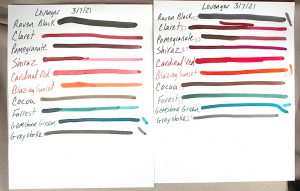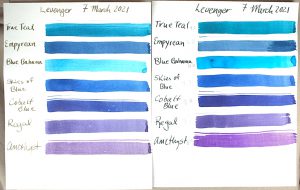Mathematical and computer genius Alan Turing famously said, “Sometimes it is the people who no one imagines anything of who do the things no one can imagine.” In addition to being one of my all-time favorite quotes about people, it seems to apply to the world of fountain pen inks, too.

Here is a side-by-side comparison of Levenger’s ink left in the sun for 3 months and the proof sample saved in the dark.
Ink collectors today understandably go ga-ga for Iroshizuku, Diamine, ColorVerse, J. Herbin, Noodlers and many other brands. Yet, often overlooked, is Levenger’s Ink. In many respects, Levenger’s kicked off the ink-color craze a decade or two before our current manufacturers and spectrum were readily available. Levenger’s has had scores of inks of every hue available since some time in the 1990s. Better yet, they are far more affordable than the competition.
Nevertheless, I kinda blew them off…until I stumbled into a large collection for sale. When Dawn and I started testing them for UV light fastness and pH balance, we were blown away.
We started testing 17 colors in March. From March 7, 2021, through June 7, 2021, we hung these samples in the sunniest window of our house. Afterward, we tested the ink still in the bottles with a pH meter calibrated to 21ºC.

Here is a side-by-side image of Levenger’s inks left in the sun for 3 months and the sample proof left in the dark.
Without a doubt, these are the most consistently light-fast inks we have tested to date. Even the worst-hit inks were still very close to their original colors. Blue Bahama likely lost the most vibrancy, but it is still easily read and distinguished. Cardinal Red faded to a rich pink, but it is still quite legible. Raven Black, Gemstone Green and Greystoke got DARKER in the sun!
Given the great results from the light-fast testing, we feared the worst with the pH tests. BUT! We were only further dazzled. Many of the inks were very close to neutral, and none of the inks veered off the spectrum of acidic or alkali.
As a basic chemistry refresher, 7 in a pH test is neutral. Distilled water is 7. The closer to 0 you go, the more acidic something is. In the opposite direction going up to 14 is more base or alkali. In theory, you don’t want an acid or a base sitting in your ink sac for too long. Yet, one thing we always like to remind people is that regardless of what the pH result is, we do not know the chemistry of the ink nor how it interacts with your rubber ink sacs, celluloids or converters and the like. Depending on the chemical reaction between the ink and what it is resting in, a neutral ink can do damage and an acidic ink might be safe. The pH measurement is simply a data point we find fascinating, but it doesn’t necessarily indicate which inks are safest for your pens. With that in mind, here are our Levenger pH results:
Ink Color pH Measurement
True Teal 7.1
Empyrean 6.8
Blue Bahama 6.6
Skies of Blue 7.3
Cobalt Blue 8.0
Regal 7.2
Amethyst 8.4
Raven Black 8.3
Claret 8.7
Pomegranate 8.3
Shiraz 8.7
Cardinal Red 6.8
Blazing Sunset 6.7
Cocoa 7.3
Forest 7.1
Gemstone Green 7.2
Greystoke 7.4
As always, I hope you find this information to be interesting and enjoyable.


 Shopping Cart
Shopping Cart





Hi Nathaniel,
I like Levenger’s inks also, but I had a problem with bottles of Raven Black in approximately 2016, where the ink was so thick that it simply clogged up my pens. Levenger very kindly sent me another bottle of R. Black and it was just as thick and nasty as the last. When consulting customer assistance a second time, I asked for a bottle of blue to make up for the bad black, they did it. They were excellent to work with and I was happy. But I’m less likely to buy their black ink again. Was the bottle that you tested just dandy? Did it work well in your pen(s)? Did it exhibit dry starts at all or clogging? I ask because I might just buy another 4-pack of their ink again, including the black, iff the black works as well as their other colors. If it worked well for you, then I assume I had a bad batch.
Hi Will! Thanks for such a great observation and question. It is quite likely the bottles we tested predate 2016. We bought an extensive collection of more than 300 bottles of ink from an estate. It is unknown how old each of the bottles are. I did not have any trouble with the Raven Black, but it could have been a much earlier or even more recent than 2016 vintage. However, I must also say that I haven’t written with it very much. I’m working through a 1980s’ bottle of Sheaffer Jet Black ink at the moment and am using it pretty exclusively. My testing with the Levenger was mostly UV and pH based. I wish I had better answers for you than that. It is good to know Levenger gave you good customer service. Levenger has undergone a transition in leadership within the past year or so, and it is quite possible it is updating its quality controls, but I honestly have no idea. Hopefully, some part of this helps a little. Thank you for writing!
My two first bottles of ink “back in the day,” sometime between 1998 and 2000 were Levenger Cobalt Blue and Raven Black. I finished the Cobalt Blue years ahead of Raven Black, which I finally emptied in 2013. Even after that many years I don’t recall the behavior you describe. As I don’t often use black (Pelikan 4001 Blue Black has become my defacto black.)
Thanks for the report bro!! Enjoyed the read!